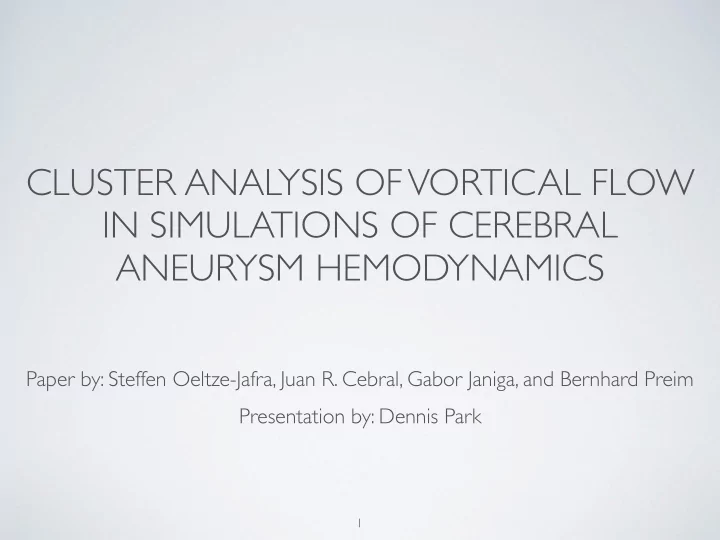

CLUSTER ANALYSIS OF VORTICAL FLOW IN SIMULATIONS OF CEREBRAL ANEURYSM HEMODYNAMICS Paper by: Steffen Oeltze-Jafra, Juan R. Cebral, Gabor Janiga, and Bernhard Preim Presentation by: Dennis Park 1
Risks of treatment: • Small but non-trivial risk. • Relatively low risk of rupture. Risks of non-treatment: • In the event of rupture, very poor prognosis (near 50% mortality rate)
FACTORS OF ANEURYSM RUPTURE RISK • Geometric descriptors of the aneurysm. • Properties of the arterial wall near the aneurysm. • Genetic predisposition. • Behavioural factors. • Hemodynamics within the aneurysm.
PREDICTIVE POWER OF HEMODYNAMIC FACTORS • Computational Fluid Dynamics (CFD) simulations are used to monitor the hemodynamics of aneurysms. • The presence of vortices within the aneurysm has been linked to increased risk of rupture . • Previous studies report frequent observation of embedded vortices (next slide).
GOAL: SUPPORT THE INVESTIGATION OF EMBEDDED VORTICES AND THEIR RELATION TO ANEURYSM RUPTURE RISK Properties of Embedded Vortices: Forms and collapses over the cardiac • cycle. The formation of an embedded vortex is • related to the emergence of a pair of equilibria, where the velocity magnitude is (near-)zero. During the course of a cardiac cycle, the • two equilibria converge along the vortex core line. Their collision corresponds to the collapse of the embedded vortex.
SUPPORTED TASKS • Discover embedded vortices • Locate the points of equilibrium • Characterize flow near the points of equilibrium
DATASET • Dataset is generated from 3D rotational angiography. • Can be thought in the abstract as a collection of streamlines • In the study, only a single point in the cardiac cycle (when the embedded vortex is at full manifestation) was considered.
PREVIOUS SOLUTIONS Derive Cluster representative streamlines streamline for each cluster Seed streamlines passing through a pair of manually selected points on the vortex core line
Seed streamlines at various points along the vortex core line Cluster Derive streamlines representative according to their streamlines for distance from the each cluster equilibria
THE SOLUTION • Ribbons to represent streamlines. • Width of ribbon = # of streamlines in the aggregated cluster. • Arrowhead glyph along the ribbons to show direction of flow. • Spherical glyphs to represent equilibria. • Click on equilibria to highlight nearby streamlines.
CRITIQUE Pro: • Provides easy detection of embedded vortices. • Very effective reduction of data. • Overall, effectively supports the tasks it set out to support. Con: • Due to the heavy dependence on the equilibria in processing the data, it might be difficult to extend the solution to a simulation where a time-factor is involved.
Recommend
More recommend